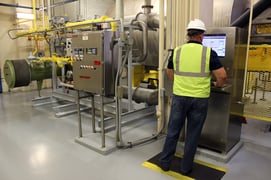7 Steps To Improve Usage of your CMMS
 April 18, 2019 by Bergen Adair
April 18, 2019 by Bergen Adair
As long as technology has been advancing, people have been resistant to it. This is equally true of CMMS (computerized maintenance management systems), and it’s a serious industry problem. Studies suggest CMMS adoption is somewhere between 30 and 60 percent depending on the groups studied.
Even those who use CMMS often struggle to get their technicians to use it — a recent industry study found that 61 percent of maintenance managers found implementing their CMMS either somewhat challenging, challenging or very challenging.
The real-life ramifications of this are widespread. First of all, it means you’re not getting your money’s worth. CMMS software can be expensive, so if your techs aren’t using it they’re wasting money. It also means you’re not operating at peak efficiency. CMMS streamlines work orders, maintenance scheduling and other maintenance tasks that can become costly and time-consuming when they are mismanaged. This mismanagement also contributes to workplace hazards, damaged equipment and a score of problems that you should definitely be trying to avoid.

So how can you sidestep these CMMS pitfalls? By ensuring complete adoption of your CMMS! While this task is different for every organization, there are some tried-and-true ways to make your CMMS implementation go smoothly and encourage your employees to make the most of their new software coworker.
tried-and-true ways to make your CMMS implementation go smoothly and encourage your employees to make the most of their new software coworker.
1: Work Closely With Your Implementation Partner
The first place a CMMS can fail is during the initial implementation. While almost all CMMS companies will help you get on your feet, some go above and beyond when it comes to implementation. This can include on-site coaching, training videos, 24/7 live support and a range of other user-support services that help you get started with your CMMS.
 2: Train Your Employees
2: Train Your Employees
This may seem obvious, but you’ll likely need to provide even more training than you initially think. If you’re getting your very first CMMS this is especially important, but even upgrading or changing CMMS platforms has a steep learning curve. Giving feedback to employees on performance can help them understand not only what they’re doing wrong, but how to fix it. This approach highly increases the likelihood that they will use the system.
3: Implement Gradually
Change is hard, and this is often especially true for people who like to work with their hands like technicians. If you expect everyone to use the new system all the time from day one, you’re going to have a hard time making it a reality (Unless you go the way of a fully implemented option). If multiple departments will be using the CMMS, start with one and then spread it out. This has the added benefit of employees being in a position to train other employees, a team-building and cost-effective situation.
4: Have a Solid Plan
Treat the implementation of the CMMS like you did the choosing and purchasing of it. Don’t just hope for the best — a specified training regimen for users, a goal time frame to full adoption, plans for what to do when something goes wrong, all of these are important to know in advance.
5: Make it as Easy as Possible
One reason people don’t use business software is because it’s a hindrance. Are there five hoops your techs need to jump through in order to use the CMMS? Try to cut it down to three. Are schedules easy to understand and change? Can they do it online or do they need to call in? Is there a clear chain of command when it comes to who is expected to open, perform, approve and close work orders? All these things can roughen a smooth CMMS operation, so try to focus on how each aspect of the software affects the technicians who will use it. Choosing a CMMS with mobile device support goes a long way for making it accessible in the field.
Try to cut it down to three. Are schedules easy to understand and change? Can they do it online or do they need to call in? Is there a clear chain of command when it comes to who is expected to open, perform, approve and close work orders? All these things can roughen a smooth CMMS operation, so try to focus on how each aspect of the software affects the technicians who will use it. Choosing a CMMS with mobile device support goes a long way for making it accessible in the field.
6: Show Them Results
Another way to ensure techs use the CMMS is to give them hard data. Show them physical benefits of using the CMMS vs. going without: put data into practice. This will help motivate them and make them understand the why of a new system.
7: Never Stop Improving
Developing a culture of continual improvement is key to ensuring your employees don’t backslide. If you make it part of a company-wide goal to be and do better, you’ll set yourself up for success.
One company includes implementation, data entry of all of your assets and staff training at no cost with a signed contract.
This, obviously, removes all of the barriers of self-implementation.
Every organization is different, but these general rules for improved CMMS implementation can help.
What problems do you have implementing your CMMS? How have you addressed problems in the past? Let us know in the comments!


